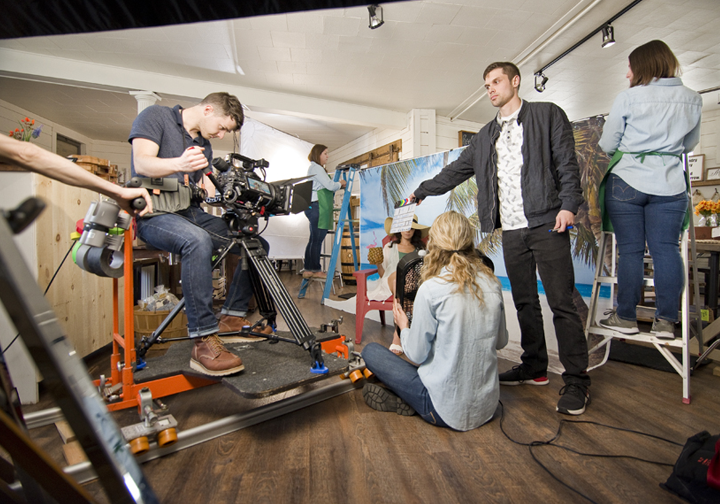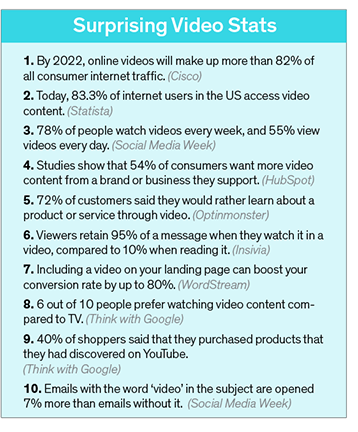

How do you create videos that get watched and shared?
Tracey Spaulding of Cold Box Films offers tips
Let’s make a video!” You’ve probably heard this phrase once or said it yourself. Marketing experts agree that video is the most effective selling tool. More so thanks to the pandemic.
It’s a common wish that you create a video and it turns out to be the next YouTube sensation. One that “goes viral.” Amasses millions of views. And sends thousands of new customers to your business.
Realistically, the probability of your video going viral is >0.0001. In fact, according to Statisa.com, roughly 50% of YouTube videos never cross 1k views. Roughly 30% never cross 500 views.
Look beyond “going viral”
So, setting aside any viral aspirations, the question becomes not if you should create a video, but how do you create videos that are effective and get watched? We sat down with Tracey Spaulding, head writer and producer of Lansing-based Cold Box Films to learn what to do first before yelling, “action!”
DETERMINE WHY YOU NEED A VIDEO
It’s natural to want to jump into creating a video, thinking you can figure it out as you go. “It’s a common mistake,” said Spaulding. “We see lots of businesses create a video then try to figure out how to get people to watch it. That approach wastes a lot of money. The days of ‘If you build it, they will come’ are long behind us.”
Important planning questions
Spaulding says to take the time to write up a quick plan by answering these questions:
• What do you hope this video accomplishes for you?
• Who should see it?
• Where are people going to see it?
• How are you going to get people to watch it?
You should revisit these questions and your answers often to keep the project and everyone involved, on track. “Consider your plan to be the foundation of your project,” said Spaulding.

Plan your video’s message using scripts and storyboards.
FLUSH OUT YOUR STORY
It’s tempting to just wing it to give the impression of authenticity, thinking viewers will be enamored with the visuals or the information you’re providing. Nothing can be further from the truth, says Spaulding.
“Regardless of the type of video it is, like a How-to video, an advertisement, or an informational piece, all videos tell a story,” said Spaulding. Your video needs to flow like a story. It needs a beginning, a middle, and an end, regardless of the content.”
Viewers attention spans
Spaulding also advises keeping the viewer’s perspective in mind during the creative process. “Viewers have a very brief attention span,” said Spaulding.
“You are competing against a sea of videos. In fact, more than 500 hours of video are uploaded to YouTube and Facebook every minute. Viewers only care about your video if it is useful or entertaining to them.”
Look at your content through the lens of the viewer
Ask yourself: what’s in it for me if I watch this? If you find the video is more about appeasing yourself or your business interests, then you need to revisit your plan because your audience inherently knows the difference. If you are short on content, use case studies and customer testimonials. Both are fantastic tools to use to tell an authentic story.
Make sure your viewers can relate
For example, if your video showcases people, how are these characters reflective of your audience? Will they see themselves in them? The more your viewers can identify with what they see (and who they see) onscreen, the more likely it is that they will agree with your message. This is POWERFUL.
FOCUS!
This point is so important it bears repeating, says Spaulding. Focus your video on a single topic with a single objective. It’s tempting to think more is more. But that logic tends to confuse the viewer. And your original intent could be lost on them.
“It’s tempting for brands to want to ‘say it all’ in one video, but that usually proves to be ineffective,” said Spaulding. “It’s better to be brief and create more videos on separate topics like a series versus cramming everything into one video.”
Planning is everything
Spaulding is also a big proponent of planning your video’s messaging in the form of scripts and storyboards BEFORE the camera rolls. This ensures you and the project stakeholders are fully aligned on your vision. Taking this action will mitigate costly revisions down the road.
Make time for script read-throughs and rehearsals, so all participants understand their cues and are comfortable with the material.
“Great videos are made in the planning phase, which is where my team spends the MOST time, said Spaulding, “Showing up to set and ‘figuring-it-out-as-you-go’ is a recipe for regret later.”
OPTIMIZE YOUR VIDEO FOR SEARCH
This is a dry task, but necessary. YouTube is full of videos that people never watch. Viewers primarily use search to find videos. A video’s title and description are the most common reason why viewers choose a video to watch says Spaulding.
Also, using closed captions help from a Search Engine Optimization (SEO) perspective by increasing your video’s chance to be found.
“We live in a multitasking world,” said Spaulding. “Most viewers watch videos on mute. Adding captions helps to keep your audience engaged and will draw more eyeballs to your content.”
Connect your message to search
As you plan your video’s content, search to see what viewers are searching for that connects with your product or message.
There are many guides on how to optimize video for search. Do a quick Google search to find one that’s right for you.
WHAT DO YOU WANT VIEWERS TO DO?
At the end of the video, it comes down to the brass tax – the call-to-action (CTA). Once a viewer watches the video, what action do you want them to take? Share the video? Call you for more information? Sign up for a seminar?
A call-to-action is like shinning a light down a path to purchase,” said Spaulding. “A call-to-action is your moment to start a new connection with a potential customer.”
Placing a CTA
Because of brief attention spans, brands tend to add a CTA earlier in videos to get viewers to click through. Spaulding isn’t a fan of this approach.
“If you’re telling a good story, the end of the video is the perfect spot for your call-to-action, said Spaulding. “In my opinion, the beginning of the video grabs the attention, the middle earns their trust, and the end plants ‘the ask’.”
Don’t overlook “the ask.” Many brands do!
“The key to getting viewers to watch your video until the end is to tell them a great story,” said Spaulding. “It’s also important to do that within a timeframe that’s easy to commit to.”
Start small
As with most social media tools, start small with your video efforts, and learn as you go, says Spaulding.
“You’ll notice most brands leverage a mix of video content from Instagram reels to highly produced commercials,” said Spaulding, “Both have their place.”
Spaulding says that ff you’re looking to dip your toe in the water, start with low-risk options like Tik Toks or Instagram stories. See what gels with your audience.
Want to learn more, visit Cold Box Films.
Read Next
